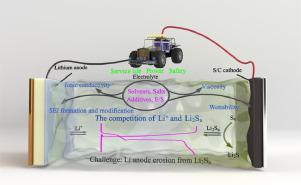Energy Storage Materials ( IF 18.9 ) Pub Date : 2020-09-20 , DOI: 10.1016/j.ensm.2020.09.009 Yilong Lin , Sheng Huang , Lei Zhong , Shuanjin Wang , Dongmei Han , Shan Ren , Min Xiao , Yuezhong Meng

|
To meet future application requirement for large-scale energy storage systems, as a promising candidate, lithium–sulfur battery has attracted extensive attention and has been thoroughly explored due to its high theoretical cathodic capacity (1, 675 mAh g−1) and the low cost of sulfur. Its practical application is hindered by the known challenges, including inferior cycle stability and low charging efficiency etc. despite extensive studies in last decades. Most researchers have focused on developing novel host materials for sulfur cathode, protecting lithium metal anode by artificial SEI layers, and structure optimization of Li-S battery. The primary issue is the high solubility of lithium sulfide intermediates (Li2Sn, 3≤n≤8) in liquid organic electrolytes, which results in a “polysulfide shuttle effect” and rapid capacity fading. Compared with solid-state electrolytes, up to now, traditional liquid state electrolytes are still the most favorable choice for the commercialization of Li-S batteries. Each component of liquid electrolyte, such as solvents, lithium salts and additives, is related to dissolution of polysulfide intermediates and formation of SEI film on lithium metal anode. Motivated by strong demand of the state-of-art electrolyte systems for high performance Li-S batteries, researchers have tried to explore more novel electrolyte systems. In this review, the recent progress of liquid electrolyte systems are summarized and discussed. In addition, we also review some new concepts and the reaction mechanisms of the electrolytes in Li-S batteries.
中文翻译:

Li-S电池中的有机液体电解质:现状和观点
为了满足未来对大型储能系统的应用需求,锂硫电池由于其高理论阴极容量(1,675 mAh g -1)和低的理论容量,受到了广泛的关注,并受到了广泛的研究。硫磺成本。尽管近十年来进行了广泛的研究,但已知的挑战阻碍了其实际应用,包括较差的循环稳定性和低充电效率等。大多数研究人员致力于开发用于硫磺阴极的新型主体材料,通过人工SEI层保护锂金属阳极以及对Li-S电池进行结构优化。主要问题是硫化锂中间体(Li 2 S n(3≤n≤8),这会导致“多硫化物穿梭效应”和快速的容量衰减。与固态电解质相比,到目前为止,传统的液态电解质仍然是Li-S电池商业化的最有利选择。液体电解质的每种成分,例如溶剂,锂盐和添加剂,都与多硫化物中间体的溶解以及在锂金属阳极上形成SEI膜有关。由于对高性能Li-S电池的最新电解质系统的强烈需求,研究人员试图探索更多新颖的电解质系统。在这篇综述中,总结和讨论了液体电解质系统的最新进展。此外,我们还回顾了Li-S电池中电解质的一些新概念和反应机理。











































 京公网安备 11010802027423号
京公网安备 11010802027423号